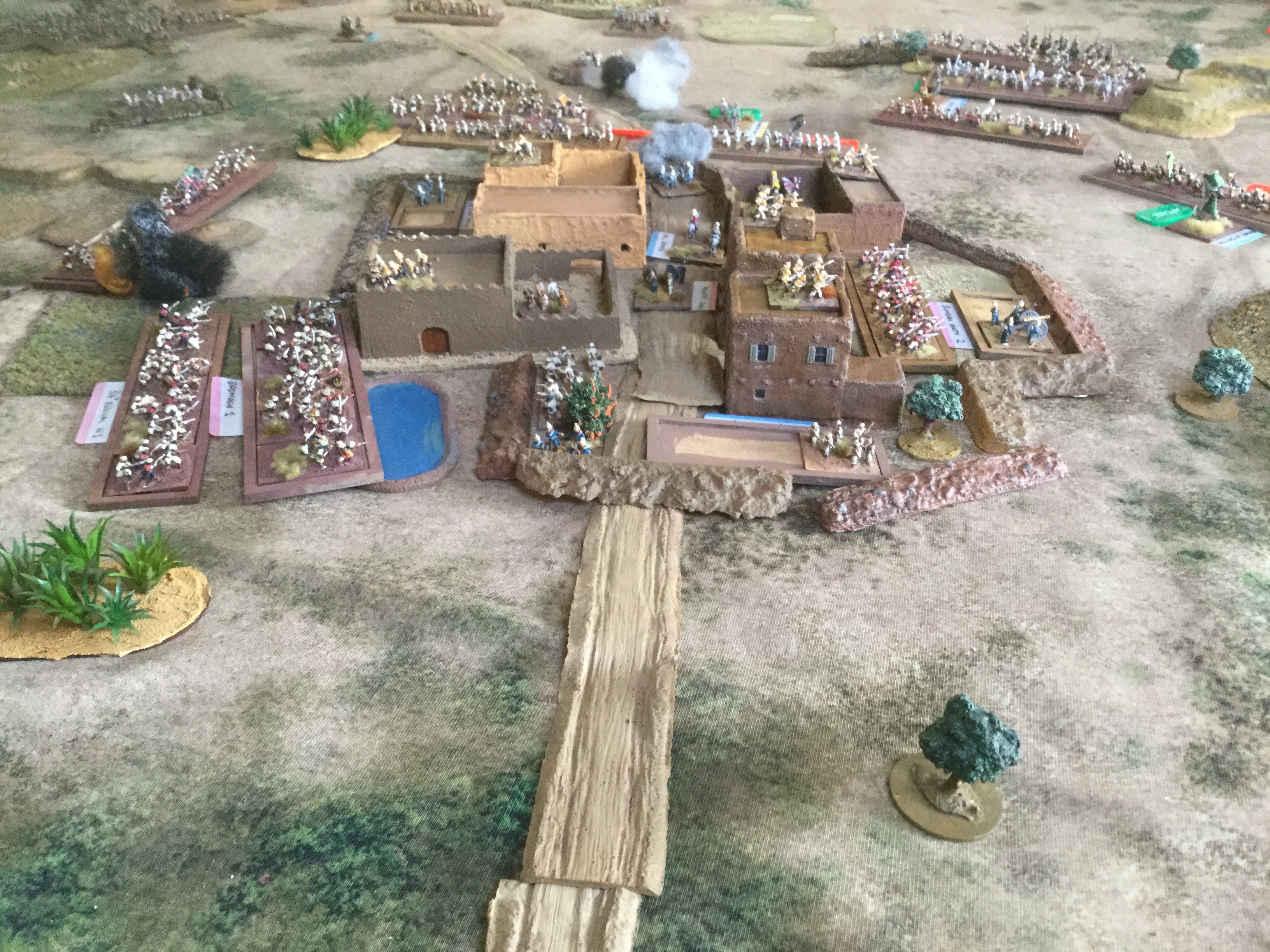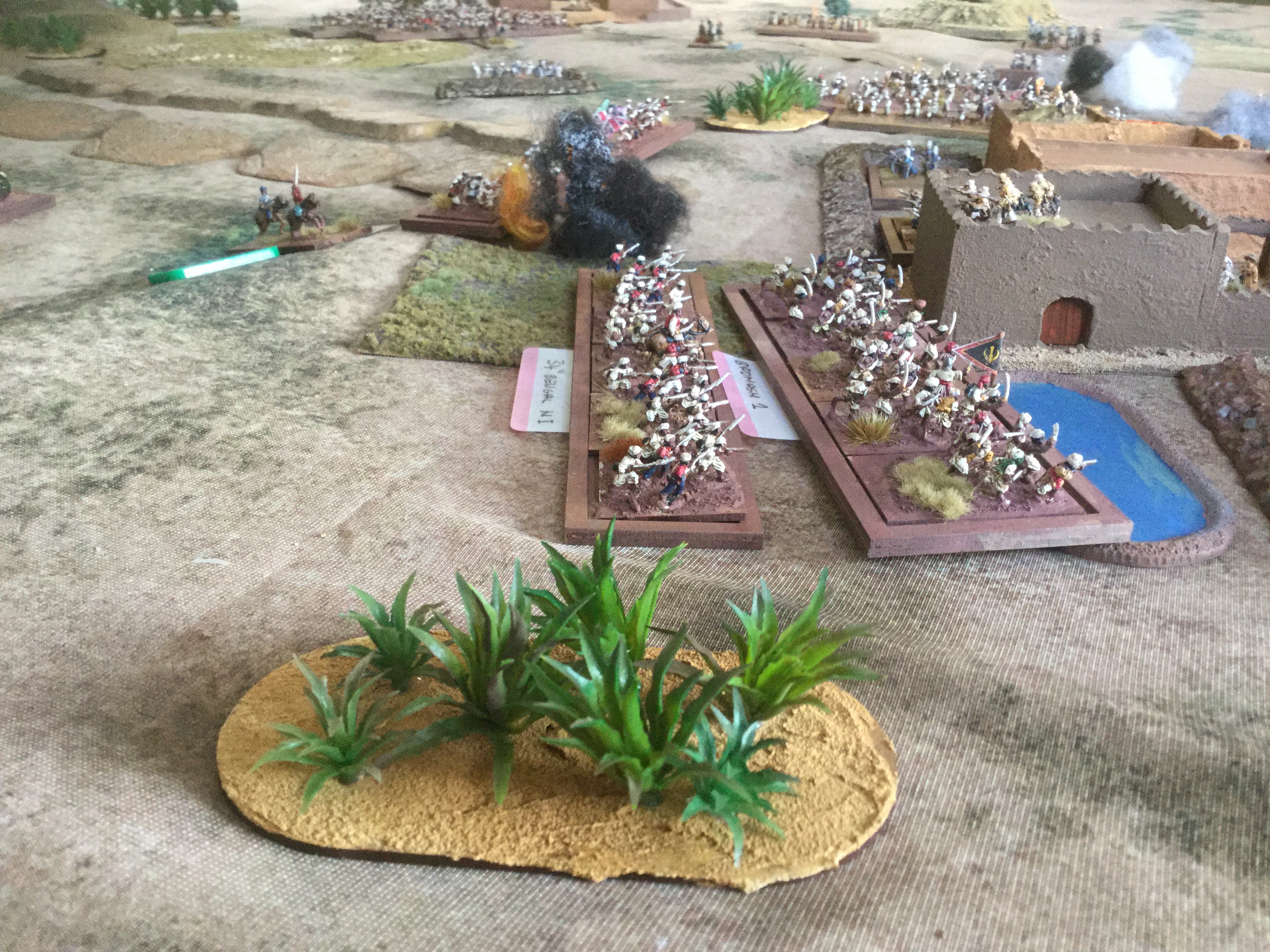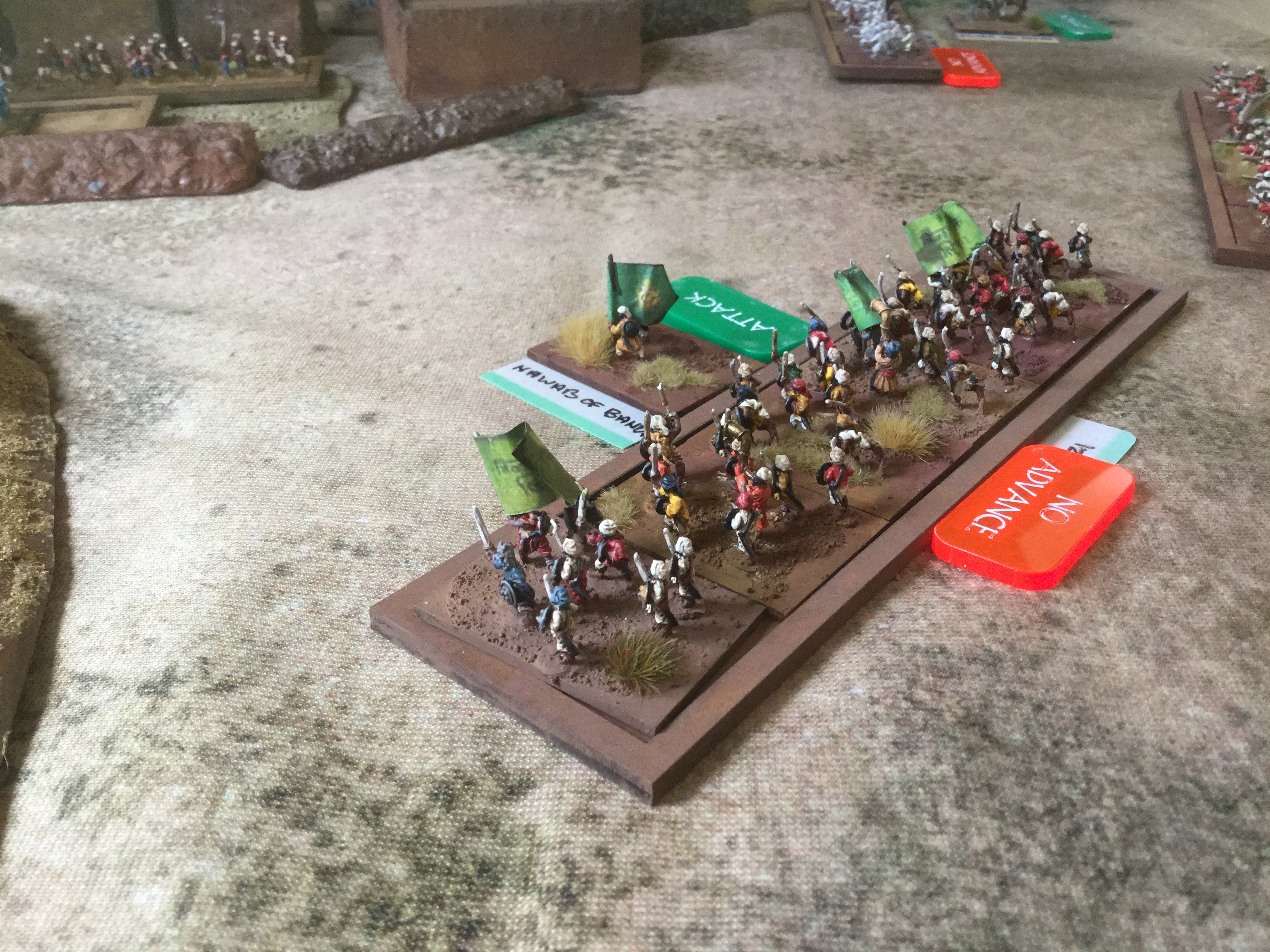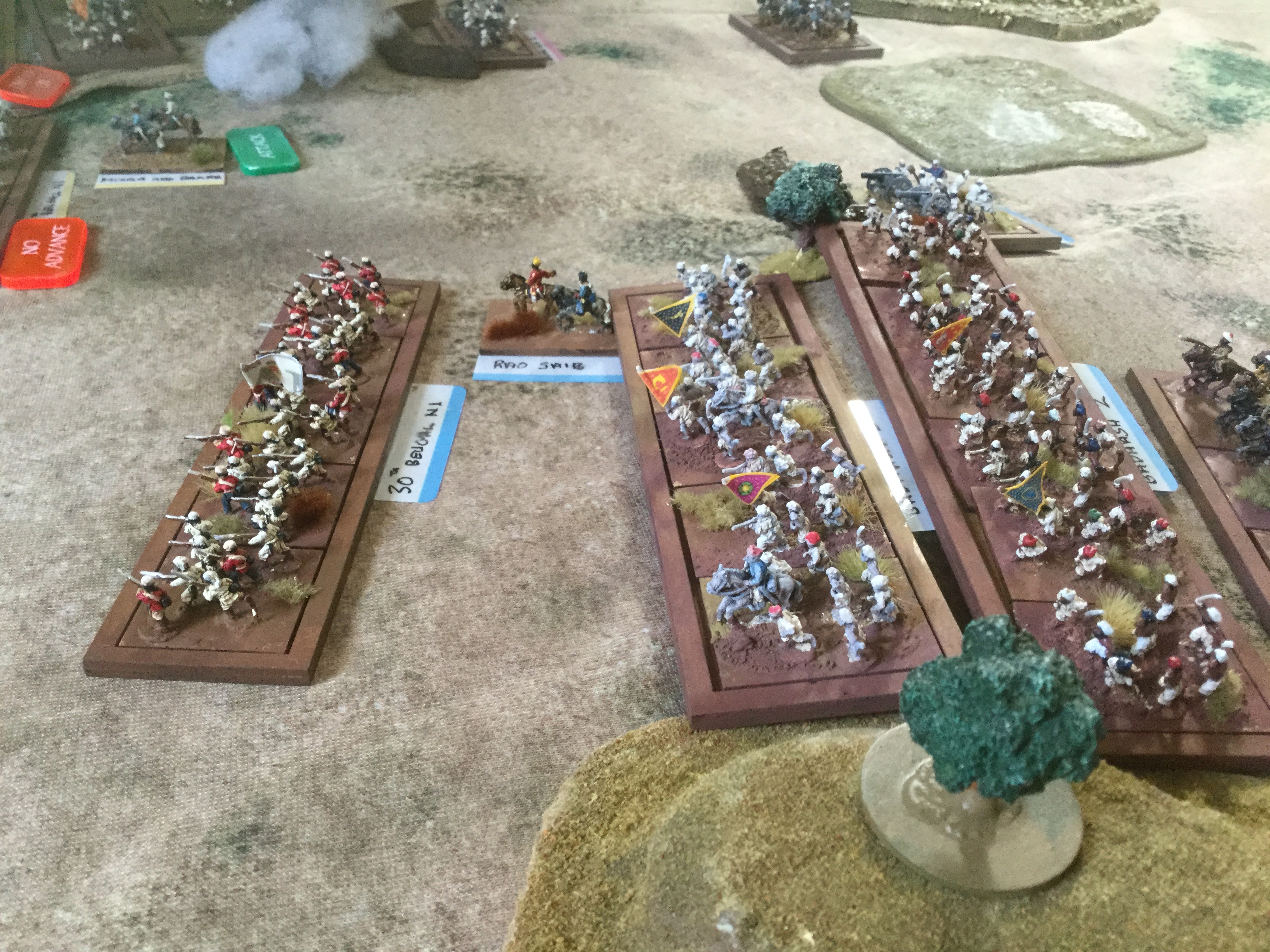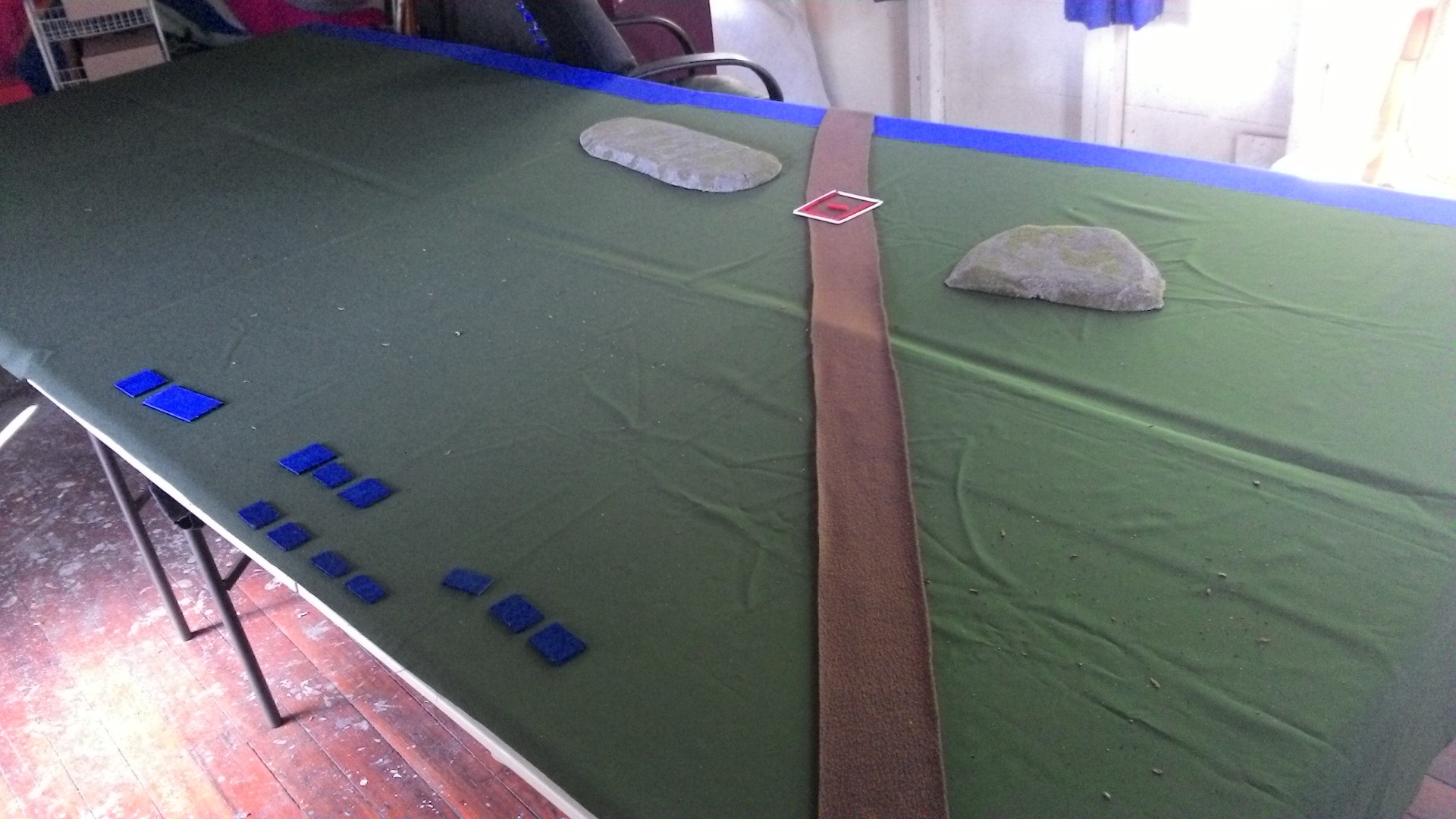 Zulu Enter Confronting the British in the hastily prepared redoubt.
Zulu Enter Confronting the British in the hastily prepared redoubt. 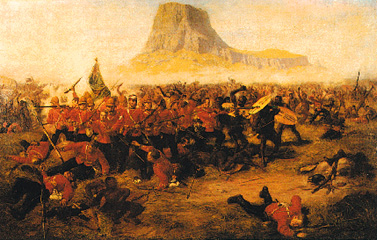 24th Rgt. The South Wales Borderers - Isandhlwana.
24th Rgt. The South Wales Borderers - Isandhlwana."Imperial Splendour" is a computer based set of miniatures rules for 16th to 19th Century Imperialism in Asia, Africa & the Americas. This is probably the most diverse period of wargaming we have encountered. It encompasses Late Stone Age cultures (eg. Zulu, North American Indian ), Feudal cultures in Asia (eg. India), and upheavals in these cultures sparked off by the advent of Imperialism itself (eg Indian Mutiny, Sikh Wars, Boer Wars, The Opium Wars, Boxer Rising). We have been able to incorporate the Indian Wars of the North American West in this module as well.
Beyond this geographic area and time period, the introduction of new military technology alters the basis for warfare to such an extent that it is historically unrealistic to pit a force from an earlier period against one from the later period. Our research tells us however that this will still allow a large number of gamers with different armies in the period to play each other without the hobby degenerating into "fantasy gaming". Please let us know what you think. By the way, we have nothing against fantasy gaming, our fantasy module (Skull Cleaver) is now available. It supports miniature wargaming styled after Lord of the Rings.
Imperial Splendour assumes you either have or are about to build your own miniature war games army. However, if you do not wish to go to the trouble of buying and painting figures then such an army can easily be constructed from coloured squares of cardboard that represent the units and generals. Write the name of the unit or general underneath its cardboard representation and you are ready to play Imperial Splendour. Although dimensions are suggested in the documentation. Imperial Splendour is so flexible you can use the basing suggested by any rule set, as long as both armies use more or less the same one.
Imperial Splendour is also a game for war gamers by war gamers. It grew out of the desire for fewer rules and more realistic table top figure war gaming. To reduce costs, it has been produced with a maximum of attention to the game and a lesser degree of attention to the usual packaging glitz. We hope this puts it within the reach of the majority of wargamers.
We are always looking for ideas from players as to what to include or change. It is a "for wargamers by wargamers approach" with the system being sold at minimum cost to encourage computer based gaming as a generally acceptable approach. New versions are being developed on an ongoing basis.
The new Version allows you the ultimate in army, battle and campaign size. There is no limit on the number of units or officers in an army! Battles can have any number of sides and any number of armies on each side! This accomodates even the largest club campaign game. Imperial Splendour also provides the enhanced Windows usability that allows greater ease of use and faster play without the PC intruding into the players awareness.
Back to Top
 Assinibion Chief.
Assinibion Chief.The Create Army module creates each army separately so that at battle time each army only need selected when you need it. At the start of a battle Imperial Splendour asks you for the number of sides and the number of armies on each side. This gives you the flexibility to play any army you have against any (or all!) others. You don't have to associates opponent armies at the time when you create them. When in the Create Army module you may save your data at any time. You will also be prompted to save your data once you exit or open another army. Armies may be as large as you like now. Some of the main data elements used to describe units and officers are:-
Name. Up to 40 characters per unit or officer is allowed so that longer names can be accomodated and the historical 'feel' preserved;
Training Level. This ranges over a five point scale from Ill Trained to Highly Trained.
Size of Unit A unit would have the number of troops in it and can be further sub-divided into a number of subunits or elements to allow fire or melee to be split or to represent historical subdivisions such as squadrons within a Battalion. Units may be split to form new units as well as combined.
Weapon types. This includes a larger range of options than before such as Smoothbore Muskets, carbine, earlier and later rifles (eg Lorenz Rifle Musket), breachloaders (eg Chassepot and Dreyse Rifle) , magazine rifles (eg Mauser). A a variety of smoothbore and Rifled artillery calibres (eg 6 Pdr, 8 Pdr etc), field howitzers, of different calibres and rockets. The effectiveness of rockets has been toned down to match the historical level of inaccuracy. Early machineguns are also a feature.
A range of weapons such as bows, javelins, darts, thrusting spears and axes are provided for native troops.
Trooptype. A wide range covers most types of infantry and mounted troops (eg Light Infantry, Lancers, Dragoons, Light and Heavy Cavalry, Camelry and Elephantry), artillery, fortifications and naval types (Battleship, Armoured and Protected Cruisers, early Submersibles etc);
Armour. Naval vessels have the option for the player to vary the depth of armour at different points. This includes sides, decks, turrets, internal armoured belts, waterline belts and so on. Both maximum and minimum depths of armour may be specified so as to allow the representation of weak points. In battle the system determines which point is hit, the armour depth at that point and whether the round penetrates. Rounds do not necessarily penetrate as the angle of the hit may dictate a ricochet.
Skirmishers. Line units can be designated as having one or more subunits of skirmishers and can either deploy the whole unit as skirmishers or keep a proportion back as a parent body. For example, this allows the third line to skirmish. Specialist Light Infantry skirmishers such as British rifle units are also allowed for.
Tactical Style. Even within the same army and nationality, units vary greatly in their battlefield behaviour since they are composed of troops drawn from widely varying backgrounds. This is allowed for by the use of the Tactical Style feature, which gives the unit a different battlefield behaviour pattern. The Tactical Styles accomodated in this period are Regulars, Irregulars, Fanatic, Colonial, Colonialised, Europeanised and Woodsmen.
Although most European troops are Regulars in this period, some such as Boer Commandos could be classed as Guerillas. Sepoy units could be classes as Europeanised. Troops such as Afghanis are probably best classed as Woodsmen. Woodsmen are particularly good as skirmishing from behind cover, but not so keen on close quarters fire fights out in the open. Troops such as Gazis who were considered more aggressive can be classed as Fanatic. The documentation accompanying Imperial Splendour advises on the meaning and application of each tactical style. The option is provided to give players the freedom to express their historical view of their favourite army.
Morale and Fatigue can be preset before a battle to match historical circumstances such as prebattle forced marches or a prior loss/victory in a campaign.
Flank March arrival times are also preset before battle, although the arrival depends on a number of historical factors such as the commander's ability and the capacity of the troops he is commanding.
Generals and their orders also receive full attention as the officers personality, efficiency, orders and place in the chain of command is established. Each army has a CNC, Corps level commanders and Divisional level commanders. The interaction between these commanders and the resulting effect on units is controlled by the flow of orders and the officer characteristics. At particluar points in the battle (eg Rallying from Routing) these factors are taken into account by the system in determining the outcome. This allows quite complex evaluations of unit behaviour witjhout any extra burden on the player.
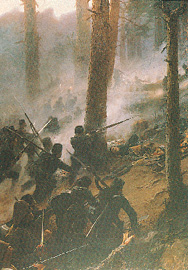 5th Ghurkas at Peiwa Kotal 1878.
5th Ghurkas at Peiwa Kotal 1878.The Battle module has four phases.
1. Deployment. At the start of each round use the Deployment Phase to perform all the actions that are preliminary to combat, such as formation changes, sending Orders, testing for Charges and testing for other events such as a unit's success at scouting or movement through difficult terrain. You should think carefully about your tactics before you issue directions. For example, if a command has been on the defensive (with Hold Orders) and the enemy attack is faltering, you may decide to attack soon. Think ahead and send an Attack order some rounds in advance. Once it arrives and you want to encourage the men to charge, then send their commander to join the key unit BEFORE you test for the charge. Sending him afterwards will be too late. Remember to allow some margin for delays and errors such as a misinterpretation of Orders. This is part of the "fog of battle" built into Imperial Splendour. You will find that it is quite a challenge to control a battle without modern aids such as direct radio contact. It gives the sensation of how it must have been and you may feel more sympathy for generals of those times after the experience.
A unit that has been involved in a test to charge will not be given a result immediately. This will be given once you move to the next phase (Bombardment). The reason for the delayed notification is that the unit may be involved in more than one charge and these may be against different types of targets. Consequently the total situation needs to be evaluated before the decision can be made on whether the unit charges, stands, runs etc. The total situation is only available once the Deployment phase is concluded.
After players have finished Deploying, choose the next phase, which is Bombardment.
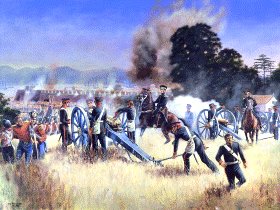 Madras Foot Artillery - Assault on Chin KIang-Foo.
Madras Foot Artillery - Assault on Chin KIang-Foo.2. Bombardment. By 'Bombardment' we refer to a situation where a battery lobs shells at long distance as quickly as practical. Bombardment became more frequently used in this period with the introduction of Rifled Artillery (1870s) and percussion shells, so we have included these features to help you to create historical battles. A battery may bombard several units during the one turn, each at a different range and with different cover characteristics and ordinance types (eg Common Shell or Shrapnel). The more units that are bombarded the more thinly spread is the bombardment and the less damage done to each unit.
Bombardment is simultaneous and the effects of firing are not applied until the start of the next bound.

Inside Square of 1st York, Lancs, and Black Watch - Tamaii.
3. Firing. To fire, the player chooses the unit from the drop down list, chooses the target and adjust the target conditions (ie range, cover type etc). Then clicks on the Fire button at the bottom of the form. The losses resulting will be displayed immediately. If a unit is firing on more than one target then the player can split the fire according to the number of elements remaining in the unit.
Firing is simultaneous in this period and the effects of firing are not applied until the next bound.
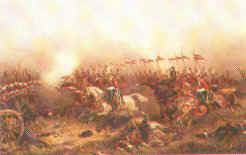 Charge of the 16th Lancers at Aliwal.
Charge of the 16th Lancers at Aliwal.4. Melee. At the start of melee, those units that have successfully tested to charge will be tested for charging home on the target in the light of the effect of any firing on them. Some may have taken unacceptable losses and may recoil without contacting their opponent. When fighting more than one target you may split the combat according to the number of elements that are available to fight.

Gordon Highlanders at Dargai.
Units that have been involved in a melee will only be given a broad interim outcome at the time of combat. The final outcome will be given once you cycle back to the first phase (Deployment). The reason for the delayed notification is that the unit may be involved in more than one melee and these may be against different types of targets. Consequently the unit may win against one but lose against another. Therefore the total situation is evaluated for you before the decision is made on whether the unit wins, loses, stands, runs etc. Then the position of the unit on the tabletop would be changed according to the outcome shown by Imperial Splendour.
Grand Tactical module is included at no extra cost.
The Grand Tactical module allows you to play against one or more opponents in the aproach moves that lead to a battle. The players deploy their commands in a landscape with terrain generated by the computer and then move towards a tabletop area marked in the centre of the table. During this Grand Tactical movement, commander ability, encounters with the enemy, difficult terrain and the excessive crowding of friendly commands can all contribute to delays and mishaps. When enough commands have entered the tabletop area the system declares the battle ready to start and exports the armies ready for battle. Commands that have not reached the tabletop area are set to flank march and appear later during the battle (you hope!). A Tactical Map of the battlefield with computer generated terrain and initial starting point for each command is provided for you to print and use as an aid to initial deployment. You now import the armies into the battle module and you are ready to fight the battle!
Solo and Campaign modules are also included at no extra cost.
The Solo module allows you to play against the system using a number of scenarios. Responses considered typical of an historical general are provided by the Solo module and are displayed for the gamer to act upon. The amount of activity needed at the screen is reduced as the Solo system handles all formation and order changes within the PC. The player does not need to perform these as well as those needed for his own side. Player intervention in the Solo side's activities is allowed however, so that inappropriate responses can be corrected.
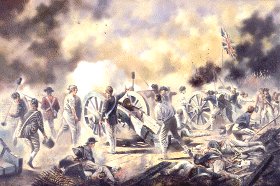 4th Battalion Royal Artillery - Siege of Pensacola.
4th Battalion Royal Artillery - Siege of Pensacola.The Campaign module allows map maneauver taking into account terrain and logistics effects on the armies. To increase ease of setup and to enhance the attractiveness of campaign games a number of colour maps with terrain displayed are automatically available for selection in the computer. The computer "sees" the map as a grid, with each sector having certain characteristics such as the arrability of the land, difficulty of the terrain etc.
The role of Quartermaster has been taken over by the system to reduce the onorous administrative load usually associated with campaigns. Bases can be created and resupply is allowed for. Losses through starvation, disease and straggling are also determined by the system. Sieges can be setup and the associated losses and the outcome are controlled by the system.
 USS Maine (Battleship).
USS Maine (Battleship).Naval rules have now been integrated with the existing land based rules. This provides the player with even more options than before. The player can either play the same land based games as before, or play a conventional naval game, or play a combined arms action in which both naval and land forces are present and can fire on each other as well as ram and board.
Each bound the system determines and displays the wind direction and strength, as well as recalculating the maximum turn and speed of each vessel based on a number of factors such as the training level, morale and fatigue of the crew and the state of the ship. A chart is provided to allow the player to calculate the ship's speed based on its angle to the wind. The damage inflicted by enemy fire includes the number of cannon dislodged, flooding and fires caused. The effectiveness of damage control in stopping these problems is reassessed each turn by the system. Under heavy fire a captain may surrender and a ship and be destroyed by fire. Close Actions such as Ramming and Boarding are also supported.
A wide range of naval guns are provided to allow the vessel to be armed historically. These include Rifled Artillery, smooth bore artillery and ramming prows. A wide range of ship types is also provided, including Battleships, Armoured Cruisers and 1st through to 3rd Class Protected Cruisers as well as Iron Clads, Armoured Vessels, early Submersibles, and smaller types such as Cutters and Gun Rafts. Armoured ships can specify their armour thicknesses for a variety of regions such as Waterline Belt, Turrets, Deck and Sides.
To add realism, several kinds of fortifications have been added to the already extensive range of troop types. These can be armed with artillery and are assumed to have their own garrison. These forts can act as fixed strong points that can bombard, be bombarded, and can resist or be overrun by storming parties. The forts range from hastily fortified positions to heavy stone forts. A cluster of these strong points can be used to represent the aggregation of strong points (bastions) that compose any major fortification.
ALIGN="Center">You don't have to have a tabletop army. You can also make blocks of cardboard with the unit names marked on them. It works as well as the scale can be more accurate.
This is a refight assuming the British are not out in the open but have occupied a hastily prepared redoubt in the Saddle next to their camp. How long they could hold on? Can they survive?
 Zulu Enter Confronting the British in the hastily prepared redoubt.
Zulu Enter Confronting the British in the hastily prepared redoubt.
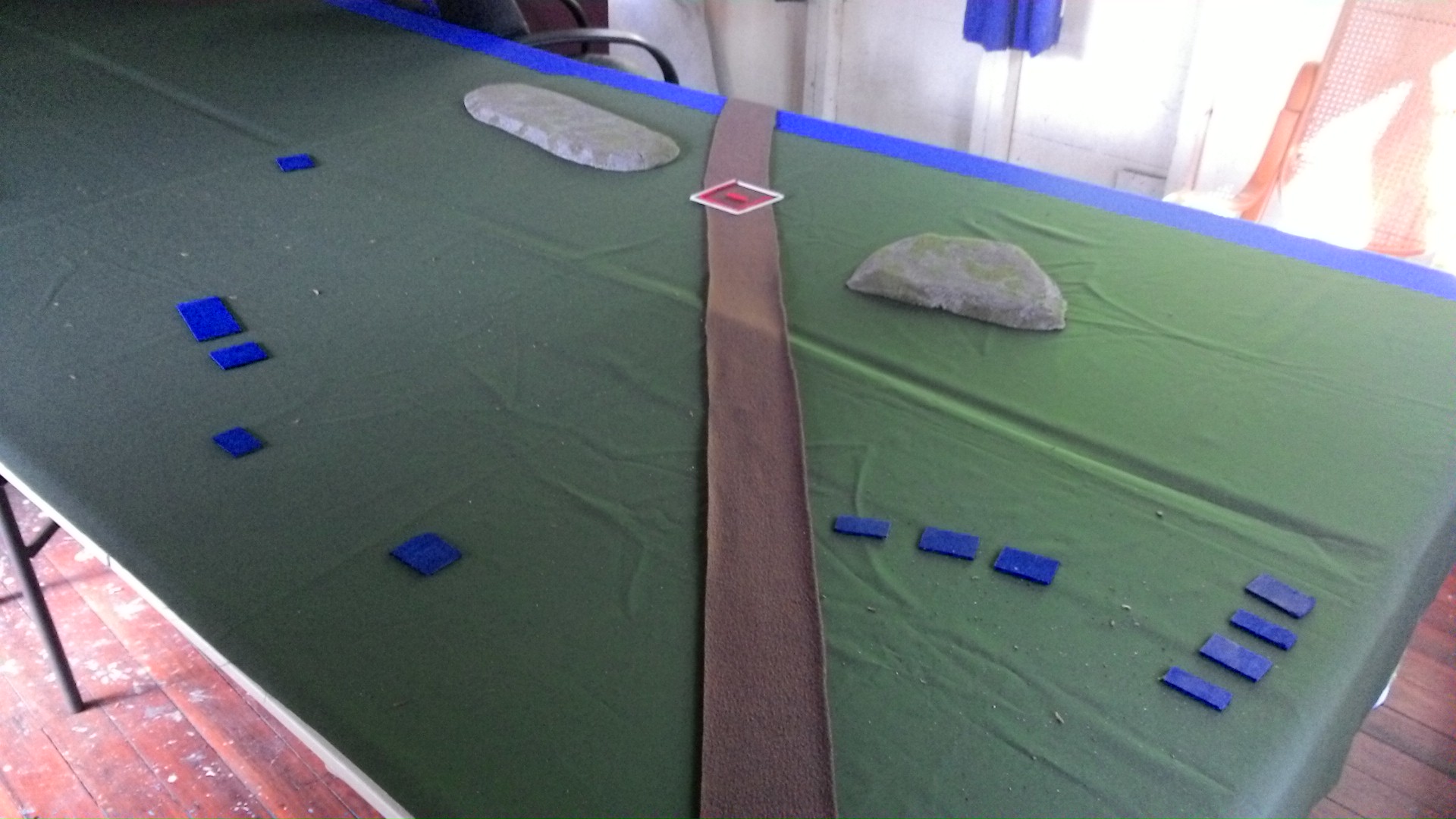 Zulu encirclement continues. Some of the Chest regimants are halted by British artillery fire.
Zulu encirclement continues. Some of the Chest regimants are halted by British artillery fire.
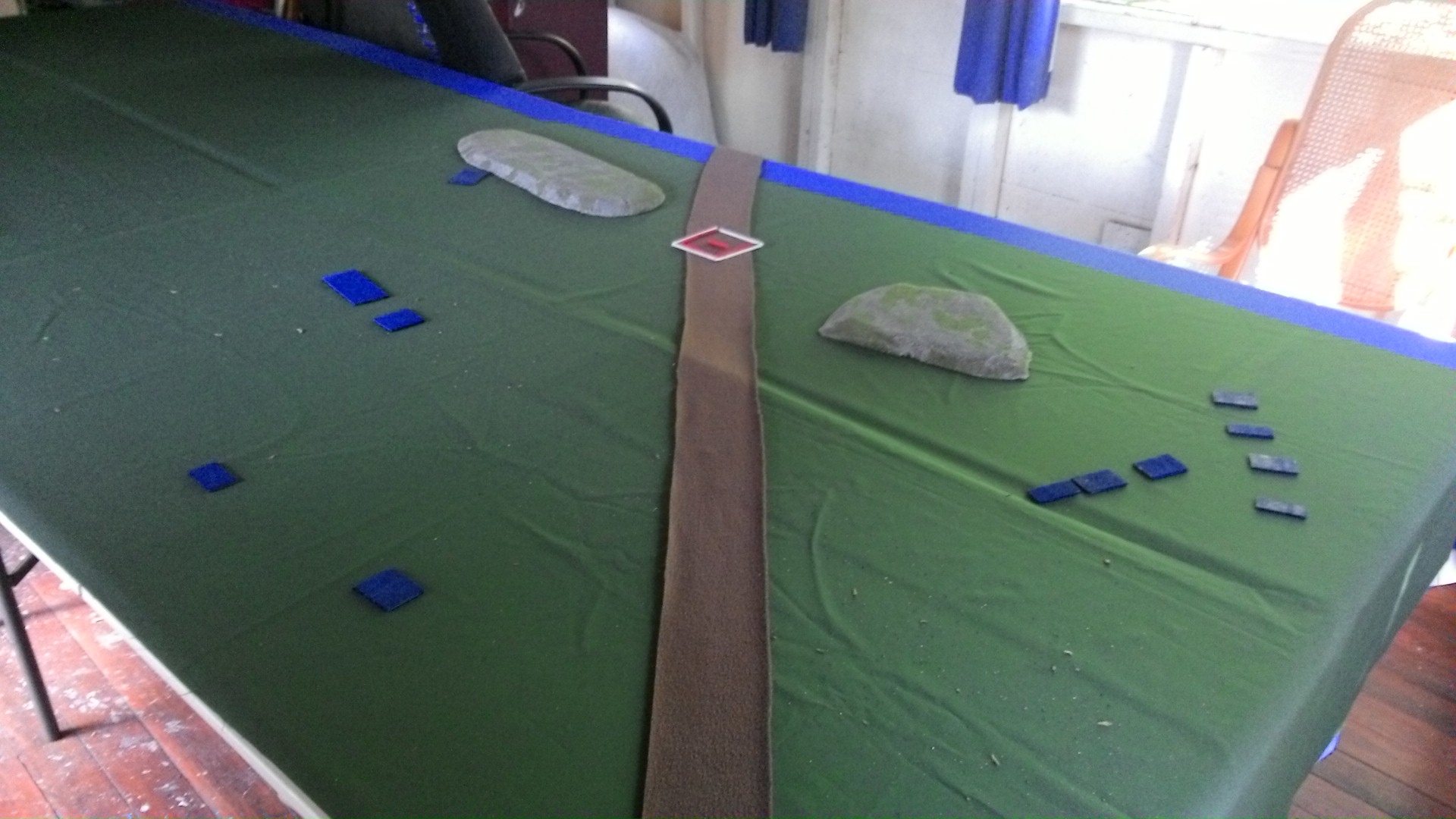 The encirclement continues with the Zulu using the tall grass and the masking effects of the high ground to reduce the effect of British fire.
The encirclement continues with the Zulu using the tall grass and the masking effects of the high ground to reduce the effect of British fire.
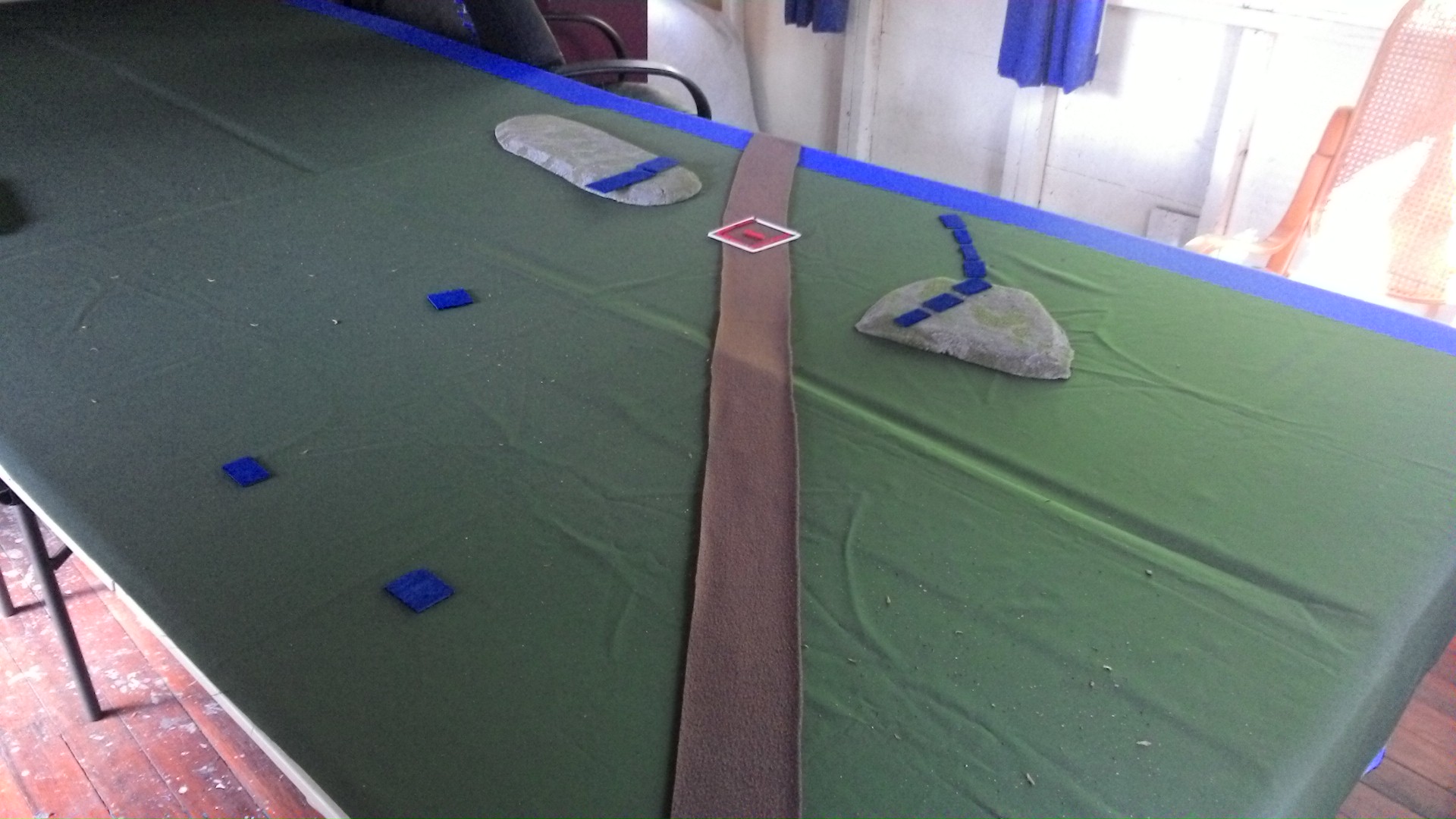 The encirclement closes with some Zulu on high ground. The Zulu armed with muskets fire on the British followed by a simultaneous attack overwhelming the British.
The encirclement closes with some Zulu on high ground. The Zulu armed with muskets fire on the British followed by a simultaneous attack overwhelming the British.
The game is the Indian Mutiny using 10mm Pendraken figures and Computer Strategies Imperial Splendour rules V6.
Essentially a small force of British East India Company troops and European volunteers are defending a small compound awaiting relief. The enemy are mixed mutineer regiments and civilian mobs.
The rules worked well and gave a good interpretation of the period. To give the mutineers any chance of success you need overwhelming numbers of mutineers and go easy on giving Enfield rifle muskets to the Europeans as the range and accuracy can cut the mutineers to pieces before they can close. It is important to reflect muddled mutineers chain of command as the commanders did not follow orders for a range of reasons such as pride, bloody mindedness and sheer incompetence- their biggest failing. So there was little or no tactical coordination and while one ‘unit’ attacked another might retreat and another sit and wait.
The acrylic markers reflect the state of the units.
